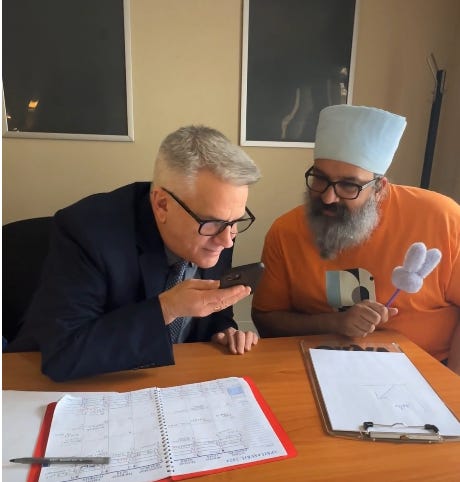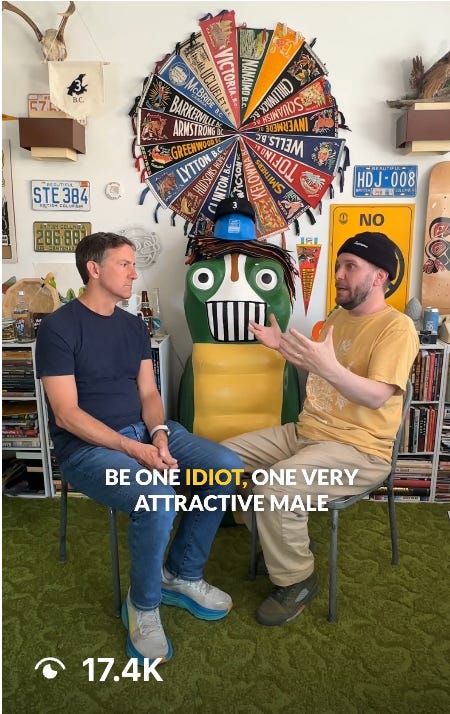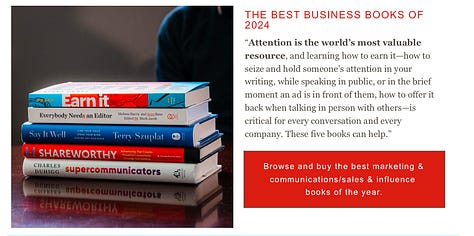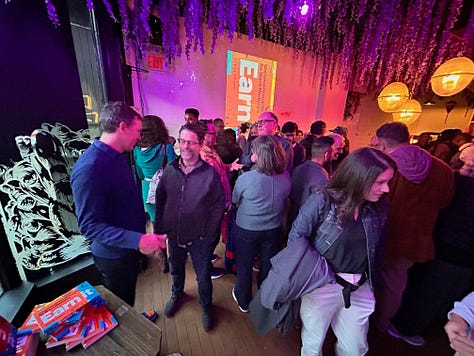15 Insights from Publishing a Book
Earn It has been out for six months. Here's what I've learned.
Welcome to the Creativity Business, a newsletter about earning attention and differentiating yourself as a marketer or content creator. If you’re not a subscriber, sign up and get content & differentiation strategy delivered to your inbox every two weeks for free.
I recently hit the six-month mark of having Earn It out in the world, and I can already say that writing, publishing, and marketing a book has been one of the most rewarding creative experiences of my career.
Many people have asked me about my experiences with publishing a book (many of whom are curious about writing a book of their own!), so I want to share some of the biggest lessons I’ve learned so far.
Six Months of Insights
Wonderful and unexpected things happen when you publish a book. Publishing a book is a timely event that puts you top of mind for many people. As a result, consulting opportunities show up. Speaking opportunities show up. Invitations to events show up. It’s weird and almost magical. I’ve had so many surreal experiences in the last six months that would have never happened without the book.
It’s hard to sell books. You really have to “earn it” when it comes to a book sale! This is obvious, but unlike a podcast, YouTube video, or Instagram post, you have to get people to BUY a book. It’s not enough to convince them to give it a try. It’s not free. It’s not $1. It’s a real commitment, financially and time-wise. I’m so grateful to all of you who have bought a copy—thank you!
Manage expectations and measure differently. Similar to podcasts, success for most books is not defined by reach or volume. To me, so far, book success should be measured in the impact your book has on readers. The impact comes from the amount of time people spend with your stories and ideas, not necessarily the volume of people who read the book.
If you’re used to millions of downloads or views, you need to really calibrate your expectations for book sales.
There are better ways to make money than publishing a book, but there might be no better way to create an impact on others with your ideas.
My insight has been to focus on making sure the people the book is written for (brave marketers and content creators) know that Earn It exists, and to try to gauge the impact the book has on the ones that actually read it.Be aware of The Job of your book. Earn It is not designed to be a NYT best-seller. Lots of best-sellers promise quick results, shortcuts, hacks, or core ideas that are easy to comprehend. The message of Earn It is that there aren’t any shortcuts and that you have to do hard creative work to get results. This is a less attractive proposition than becoming a millionaire in a weekend :-) Would I change the message of the book to sell more copies? Absolutely not. This is the book I wanted to write because I know that what’s in the book is true and it works.
There are no shortcuts. A book will not sell itself just because it exists. You need to market the book, and that requires a lot of effort over an extended period of time. And over that extended period of time, you have to be consistent with your quality and messaging. Patience is required. I am regularly reminded of a section in the book when Michael Bungay Stanier talks about marketing The Coaching Habit for two years… before it took off and became a million-copy seller.
Book success is about more than just the book. Most book businesses are an ecosystem. I think it’s smart to think about success as the aggregate of everything that comes out of having a book. There are two different ecosystems to consider.
The first is a revenue ecosystem. The book itself generates revenue, but it also leads to all sorts of other revenue that would not exist without the book, including speaking, consulting, coaching, and courses.
The second ecosystem is content. When you build a multi-platform content ecosystem, the impact of the ideas in the book reach a lot more people, and each element in the ecosystems serves as marketing for the book or your other revenue streams. Whether it’s a newsletter, a podcast, a YouTube channel, or social posts and videos, looking at the overall numbers in your ecosystem shows a more accurate picture of the impact your ideas are having on others.
The backbone of both the revenue and content ecosystems is the book itself. None of the other elements would exist without the book existing first.You become whatever you write about. I wrote the book to wrap up a chapter of my life and career by sharing all the best strategies and ideas I’ve learned from working with all sorts of amazing brands at Pacific Content, as well as from a lot of time in podcasting, television, radio, and digital media. Before the book, most people thought of me as the “podcasting with brands guy.”
Post-book, it’s been very noticeable that a decent chunk of people think of me as “the attention and differentiation strategy guy” and “the author./speaker.”Digital > traditional media. Podcasts and email newsletters are terrific for generating awareness. I owe a huge debt of gratitude to all the podcasts and newsletters that did interviews and spread the word about the book. It has, and continues to be, so much more effective and targeted than traditional media coverage, and I have a hunch that the digital properties drove more book sales than traditional media coverage precisely because they were laser-focused on exactly the right audiences for the subject matter of the book.
The book industry is comparatively (and refreshingly) slow. Again, relative to other media formats, books are a long process. They take a LONG time to write. There are multiple editing processes. There is book design and layout. There’s printing. There’s distribution to all the bookstores.
The other area that is unusual about books is that it’s slow to get a full view of how the book is doing, because there are so many retailers, there are physical books, digital books, and audiobooks.
And you know what? It’s wonderful! In a world where algorithms try to force you to publish every single day and creator burnout happens all the time, a book is a truly special creative project to undertake.
I recently read Cal Newport’s Slow Productivity advocates doing fewer things, doing them at a reasonable pace, and focusing on quality. (P.S. These are also key themes in Earn It!) You get to embrace every aspect of slow productivity with a book, and it is a generous gift to give yourself the time for a project where singular focus on a high-quality product over an extended period of time is the entire point.Each stage of the book publishing process is its own creative project. The book is about how to earn attention with creative bravery, so I knew that the book itself and all the marketing would have to employ all the strategies inside the book.
So I decided to treat each element of the process like a separate creative project, and it was so much fun. Working on the design of the book with Peter Cocking at Page Two was a creative joy. Recording the audiobook with my brilliant friends, Pedro Mendes and Gaetan Harris, and ending up with a unique and unconventional product still fills me with pride. Organizing launch events was stressful, but it paid off with two truly memorable nights full of friends and colleagues that I will never forget. And working on keynote talks that embody the ideas and spirit of the book is scary, has a steep learning curve, and is deeply engaging.


Fake Book Marketing Videos Perhaps the most fun I had was deciding to make a stupid mockumentary videos about marketing the book with Steve Scarrow and Perry Pannu, BC Bob, Jody Vance, George Stroumboulopoulos, Jordan Kawchuk, and (above) my son. Making the marketing a fun, enjoyable creative project all its own was a real joy and it made it SO MUCH easier to talk about the book with an unusual format for book marketing like this.
Launch events are overwhelming. I wasn’t sure whether to have a book launch event, but I’m so glad that I decided to do one in Vancouver and one in Toronto. The rooms were filled with all sorts of important people in my life. If you’re writing a book and not sure whether to do it or not… do it! Everyone will be there to support you in your big creative journey. It’s a surreal and overwhelming experience. (It’s a bit like a wedding. It’s a total whirlwind. It’s over before you know it. And there is no way you can have meaningful time with everyone that you want to, but everyone understands.)
Talk to other authors about their experiences. Ask them for suggestions and what they’ve learned. I talked to all sorts of authors before, during, and after launch, each of whom was extremely kind and generous with their time and insights. (Thank you to Dan Heath, Michael Bungay Stanier, Ann Handley, Jay Acunzo, Liane Davey, Ron Tite, April Dunford, Stephen Shedletzky, Gill Deacon, Larry Gaudet, Rob Volpe… and my dad!)
Don’t plan to return to ‘normal’ soon after launch. Clear a lot of your schedule post-publish date (for months!) so that you can say “YES!” and accommodate the unexpected opportunities that arrive on your doorstep.
Your book publisher matters A LOT. Be picky about who you work with as your publisher. I have been so incredibly fortunate to work with the talented and experienced team at Page Two, and I’ve always had a palpable sense that everyone on the team has been cheering for the success of Earn It. I’ve heard a lot of stories about publishers that disappear two weeks after launch, but I continue to talk semi-regularly with the sales, marketing, and promotion teams at Page Two and they continue to generate new ideas and opportunities to showcase the book. (I’m pretty sure this is quite rare in publishing!) Their goal is to work with authors who have big ideas that can change the conversation—if that’s you, I highly recommend Page Two.
I’m still not aggressive enough in asking people to buy the book or the audiobook! (P.S. if you’d like to learn how to earn loads of attention, a successful content strategy that delivers business results, and loads of actionable ideas and strategies for idea generation, differentiation, and audience growth… I have a book recommendation for you!)
Highlights of the Last Six Months
Remember above when I was talking about all the unexpected and awesome things that just magically happen when you write a book? This is what I was talking about…






Earn It was a Porchlight Business Book of the Year nominee, which is still mind-blowing to me.
After the nomination, I had a fantastic time attending my first-ever book industry event at the Porchlight Business Book Awards in New York City. (And guest lectured at Steven Goldstein’s Business of Podcasting class at NYU while I was there!)
Launch events in Vancouver and Toronto. (Huge thank you to event emcees, Grant Lawrence and Gill Deacon and to everyone who attended!)
Opening the Clever Content conference in Copenhagen (Thank you, Stine & Jesper!) and talking about Attention Forts and Chicken Purses at Radiodays Europe in Athens (Thank you, Peter, Rose, Rosie, Liedewij, and Alexis!)
Dani Saveker created a visual summary of all the big ideas in Earn It and did a phenomenal job - check it out!
As you can see in many of the photos in this newsletter, the cover of Earn It really pops. Peter Cocking from Page Two did all the cover and interior design, and I could not have asked for a better partner. He brought the whole book and the ideas inside to an entirely different level, so I was thrilled to see Peter recognized for his amazing design work by Booklife in their Cover Crush section. The number of people who have brought up the design to me since publication has been incredible - thank you, Peter!
I have had so much fun preparing unique keynote talks about the messages and ideas in the book, and, like the marketing of the book, having to use the ideas in the book in the talks themselves.
I was absolutely thrilled to be recently taken on by the amazing speaking agency, Speakers Spotlight. They’ve put together a terrific speaking profile for me, and if you’d like to book me for a talk about marketing and communication, how to earn attention, or how to stand out from the crowd creatively, just drop them an email at requests@speakers.ca. (Thank you, Martin and Lindsey!)It is simultaneously awkward and amazing to sign your own books in bookstores and to see your book in an actual bookstore, or even better, in a featured position in the front of the store. Thanks to all the booksellers who have supported Earn It, and to the team at Indigo for your enduring support of Canadian authors and publishers!
There is nothing quite like hearing from total strangers who have read your book or listened to the audiobook, who reach out to say thank you. I have had so many wonderful messages on LinkedIn, social media, and email from people I’ve never met about this book. Proof of what I mentioned above, I don’t know if there is a better thing in the world than a book if you want to impact others with your ideas!
What’s Earned My Attention Recently
A Love Affair with the Unknown Podcast
Former CBC Radio and TV host, author, speaker, and Substacker
can now add podcaster to her impressive list of talents. She is launching a new podcast about how to manage uncertainty this week and it’s full of smart interviews with folks like Oliver Burkeman, Jann Arden, and Mary Walsh.Trends vs Originality and Authenticity
I’ve mentioned the excellent Link In Bio from
before, but a recent edition really stood out for me:I know trends can be helpful for reach and brand awareness, it’s why I include a few in this newsletter every week. But original content will always be better for brand longevity. Trends tread water, original content floats to the top. When I think about the brand accounts that I love—Planet Money, Merit, Alexis Bittar, Craighill—they have created a style and vision that feels so them. Trends get users to say “Did you see this post?”, original content gets users to say “I love [INSERT BRAND NAME]’s content”. It’s a small but important difference.
Why the AI Action Figure Trend Is Doing Your Brand a Disservice
AI Tells You How To Use AI for Creativity
Jeremy Utley wrote Ideaflow, a book about idea generation, that published right before ChatGPT was unveiled to the world. He has spent the time since then delving into how to use AI to be creative. This video is a pretty interesting take on how to use AI, especially the part about how to use AI to learn how use AI for your particular project or purpose.
I’m going to leave you with one final insight…
We rightly associate the power of writing with creating value for the reader. And yet, for me, act of writing also selfishly helps me figure out what I think, what I’m interested in and curious about, and what things mean to me.
Just writing this post has made me more appreciative and grateful for all the experiences of my book journey so far. Whether it’s a Substack post or a full blown book, the act of writing might be the greatest gift you can give you yourself.
Thanks for reading,
Steve






Your insights resonate deeply. On a related note, there's been chatter about a mysterious agent, R. Solace, who offers unconventional guidance to authors. Curious if others have heard of him?
This is such a fantastic post - full of joy, happy friends, and gratitude. I'm (we're) so proud of your success, especially around this book! And the takeaways are totally valuable as I trudge through my own book journey this year.